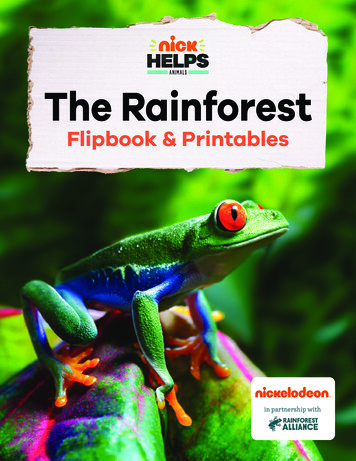
Transcription
The RainforestFlipbook & Printablesin partnership with
TeacherInstructionsHOW TO PUT THE FLIP BOOK TOGETHER1. Print or copy each page for as many booklets as you need.2. On the cover page, cut off the right side strip (as indicated). Onthe interior pages, cut around the tabs on the right side strip.3. Staple the booklet together along the left-hand side, as indicated.Fill in the Blanks1. Pass out scissors and gluesticks.2. Instruct students to cut outthe squares on the AMAZONRAINFOREST MATCH pageand discard the scraps.3. Have children match theimages in the squares to thedescriptions in the Flip Book,then glue them in place.
The RainforestCut OutStaple here 2020 Viacom International Inc. All Rights Reserved. Nickelodeon and all related titles, logos and characters are trademarks of Viacom International Inc.
EMERGENTScarletMacawA large andcolorfulparrot withbright redfeathers onmost of its body and yellow andblue feathers on its wings. Usesits strong hooked beak to breakopen nuts and seeds. This noisybird’s loud squawks and shriekscan be heard for miles.glue Animalcutout hereCan live more than 1,000 years.Produces a fruit called Brazil nuts,which grow inside a rock-hard pod.Ripe pods fall to the forest floor.People must use sharp tools toget to the nuts inside. Only oneanimal has jaws strong enoughto open the pods—the agouti.Capuchin MonkeyHarpy EagleThe heaviest and mostpowerful bird of prey.glue AnimalIt has a wingspan of upcutout hereto 6.5 feet and 5-inchlong, razor-sharp talons.The crest of featherson the top of its head make it easyto identify. Harpies prey on sloths,monkeys, snakes, and iguanas.The EMERGENT LAYER of a tropical rainforest issunny and breezy. The treetop branches have small,waxy leaves. Trees that form the emergent layer ofthe Amazon Rainforest grow as tall as 200 feet. Theseinclude the kapok tree and Brazil nut tree.Page 1Cut OutMorpho ButterflyBrazil Nut Tree
A plant that grows on trees. It haslong, curved leaves and a bowl-shapedbase. Water flows down these leavesand collects in the base. Animals visitthese plants to drink water.Howl so loudly you canhear them from threemiles away. Live insmall troupes of 4–19members. Males areblack, and females are brown. Theyeat flowers, fruits, and leaves.glue Animalcutout hereCut OutBromeliadThe Water Tank PlantBlack HowlerMonkeyCANOPYTwo-Toed Slothglue Animalcutout hereEmerald Tree BoaIn the CANOPY LAYER of a tropical rainforest,leaves, branches, and vines grow very close together.It is so thick that sunlight, rainfall, and wind cannotpass through. Flowers and fruits grow in greatnumbers and feed the canopy’s residents. Moreanimals live in the canopy than in any other layer ofthe rainforest. And many of them are very noisy!Page 2Cut OutToco ToucanA slow-moving, furry mammalthat feeds on leaves in the canopy.They hang upside down from treebranches, using their strong, hookshaped toes. Algae grows in theirfur, helping camouflage them.
The UNDERSTORY LAYER of a tropical rainforest isshady, warm, and damp. The low light makes it easy forlarge and small animals to hide. The plants in this layerhave larger leaves than canopy plants. Their large flowersattract pollinators with bright colors and strong scents.Cut OutGreater Bulldog Batglue Animalcutout hereThe face of this large bat lookslike that of a bulldog. It haslong, narrow wings, pointedears, and very large hind feet.It eats fish and insects.SparklingVioletearHummingbirdHeliconia Stricta—Lobster Claw FlowersA plant with bright red and yellow flowers that are shaped like lobster claws.Hummingbirds, like the sparkling violetear, feed on the flowers’ nectar.UNDERSTORYRed-Eyed TreeFrogJaguarPage 3Cut OutA small, bright greentree frog with redeyes. It uses stickypads on its fingers andtoes to climb slipperybranches and leaves. It eats insects andis active mostly at night.glue Animalcutout here
The FOREST FLOOR of a tropical rainforest is so dark thatit is difficult for plants to grow. Leaves that fall to the floor decayquickly. Termites, leaf-cutter ants, worms, and fungi, like mushrooms,help to decompose, or break down, any organic material that falls tothe floor. Animals such as peccaries, armadillos,and anteaters feast on these decomposers.Hercules BeetleGoliath Birdeater TarantulaThe size of a dinner plate with its legsspread out. Can eat small birds butprefers large insects, small rodents,and frogs. It paralyzes prey with venomfrom its inch-long fangs, then drags theanimal back to its burrow to eat.glue Animalcutout hereLeaf-Cutter AntsA rodentthat looks like alarge, slender guineapig. Can crack openBrazil nut pods withits sharp front teeth.Cut Outglue Animalcutout hereAgoutiColombianCup FungiBright orange, cupshaped mushrooms.Feed on rotting wood.Collared PeccaryA hoofed mammal that looks andsounds like a furry wild pig. Also calledjavelina.FLOORPage 4
AmazonRainforest MatchInstructions1. Cut out each square. Use the dotted lines as a guideto help you.2. Match the images to the descriptions in your AmazonRainforest Flip Book.
IndexInstructionsAn index is an alphabetical list of names and topics along with thepage numbers where they are discussed. The index helps the readerfind important words and topics.Create an index for this flip book, using the word bank on this page.Find the word in the flip book then write the word and page numberin this glossary in alphabetical order.WORD ANOPYPARALYZESUNDERSTORYBURROWFLOORGUINEA PIGMAMMALALGAETROUPESPREYBONUSCan you find these words on more than one page?CRESTRESIDENTSFANGS 2020 Viacom International Inc. All Rights Reserved. Nickelodeon and all related titles, logos and characters are trademarks of Viacom International Inc.
NameIndexA, B, C, DI, J, K, L, M. . . . . . . . . . page(s)BURROW. . . . . . . . . . page(s). . . . . . . . . . page(s)4. . . . . . . . . . page(s)N, O, P, Q, R. . . . . . . . . . page(s). . . . . . . . . . page(s). . . . . . . . . . page(s). . . . . . . . . . page(s). . . . . . . . . . page(s). . . . . . . . . . page(s). . . . . . . . . . page(s)E, F, G, H. . . . . . . . . . page(s)GUINEA PIGS, T, U, V, W, X, Y, Z. . . . . . . . . . page(s). . . . . . . . . . page(s). . . . . . . . . . page(s). . . . . . . . . . page(s). . . . . . . . . . page(s)4. . . . . . . . . . page(s). . . . . . . . . . page(s) 2020 Viacom International Inc. All Rights Reserved. Nickelodeon and all related titles, logos and characters are trademarks of Viacom International Inc.
NameUse information from your Amazon RainforestFlip Book to answer the questions.1. In which level do most rainforest animals live?2. What animal has jaws that are strong enoughto crack open Brazil nut pods?3. Which level of the rainforest gets the most sunlight?4. What lobster-shaped flower does the sparklingvioletear hummingbird like to feed from?Fill in the blanks.1. The calls of thehear them from miles away.are so loud that you can2. Thethat is large enough to eat small birds.is a big furry spider3. The body of the scarlet macaw is covered in brightfeathers, and it has yellow and blue feathers on its wings.What do you think?Why do you think camouflage is important for animals? 2020 Viacom International Inc. All Rights Reserved. Nickelodeon and all related titles, logos and characters are trademarks of Viacom International Inc.
Answer KeyMAMMALcanopy2, COMPOSE4PREY1, 4RESIDENTS2Agoutiemergentheliconia strictahowler monkeygoliath birdeater tarantulaEMERGENT1, 4FANGS4TROUPES2FLOOR1, 4UNDERSTORY3WINGSPAN1HIND3redAnswers will vary. 2020 Viacom International Inc. All Rights Reserved. Nickelodeon and all related titles, logos and characters are trademarks of Viacom International Inc.
animals live in the canopy than in any other layer of the rainforest. And many of them are very noisy! Bromeliad. The Water Tank Plant. A plant that grows on trees. It has long, curved leaves and a bowl-shaped . base. Water flows down these leaves and collects in the base. Animals visit










